February 12, 2010
Air Date: February 12, 2010
FULL SHOW
SEGMENTS
Hispanic Community Fights Toxic Waste
View the page for this story
In the small town of Kettleman City, California, residents recently met with public health officials to discuss if a nearby toxic waste facility would be granted a permit for expansion. Community members are fighting this permit, claiming that a recent increase in birth defects is a result of toxic waste from the facility. Zaidee Stavely has been covering the story for Radio Bilingue and talks with host Jeff Young. (06:30)
May Environmental Justice Prevail
View the page for this story
Poor neighborhoods tend to be disproportionately exposed to environmental pollution and toxins. Dillard University professor Beverly Wright talks to host Jeff Young about the Obama administration's policy on environmental justice. (06:30)
Cool Fix for a Hot Planet
/ Nirja ParekhView the page for this story
New solar panel technology has us looking to roadways to harness the sun’s energy. Nirja Parekh reports. (01:45)
Blood Minerals Fuel Congo Conflict
View the page for this story
High-tech gadgets like smart phones, mp3 players and laptops don't just offer constant connectivity and instant entertainment, they also link American consumers to the deadliest conflict in the world. David Sullivan of the Enough Project tells host Jeff Young that the global demand for minerals like gold and tantalum, essential to portable electronics, provides millions of dollars to violent groups competing for control of lucrative mines in the eastern Congo. (07:50)
Poultry Promise
/ Beth HoffmanView the page for this story
Generations of experts have dedicated their careers to finding ways to make sure children around the world have enough to eat. As Beth Hoffman reports from Uganda, some are turning to an overlooked bird to provide food and income. (08:00)
Pundits Blow Whistle on Green Police
View the page for this story
Audi new ad featured an aggressive law enforcement agency called the Green Police. The eco-officers nab people for crimes ranging from improper composting to incandescent bulb usage. Host Jeff Young asks media analyst John Carroll why this lighthearted ad has stirred up so much controversy. (05:30)
Swinging Swans
View the page for this story
Divorce has become common in our society but when swans go their separate ways, scientists take notice. This winter, a pair of Bewick Swans returned to the Wildfowl and Wetlands Centre in Slimbridge, England, with new mates, raising questions about the typically monogamous birds. Host Jeff Young talks with wildlife research officer Julia Newth about the surprising split. (05:45)
Oceanic Give and Take
/ Ari Daniel ShapiroView the page for this story
A boring lecture and journeys to the bottom of the sea gave Harvard University biologist Colleen Cavanaugh fresh insight on how creatures help each survive and thrive. Ari Daniel Shapiro has our story. (04:40)
This week's EarthEar selection
listen /
download
Hippos tell jokes at dusk in Kenya.
Show Credits and Funders
Show Transcript
HOST: Jeff Young
GUESTS: Zaidee Stavely, Beverly Wright, David Sullivan, John Carroll, Julia Newth
REPORTERS: Beth Hoffman, Ari Daniel Shapiro
COOL FIX: Nirja Parekh
[THEME]
YOUNG: From Public Radio International - this is Living on Earth. I’m Jeff Young. What’s causing birth defects in a small California town?
[CROWD CHANTING]
YOUNG: Residents of Kettleman City suspect the nearby toxic dump.
STAVELY: The chemical waste management facility there in Kettleman Hills is the largest toxic waste landfill in the Western United States. You go in and it’s basically just hills upon hills of landfill.
YOUNG: A call for environmental justice in California’s Central Valley. Also, a rare flap on Swan Lake.
NEWTH: This is actually the second time that we’ve witnesses this, but bearing in mind that’s over 40 years of studying the swans intensively at Slimbridge, and that includes the studying of over 4,000 pairs, so this really is quite an unusual event.
YOUNG: Those stories and more this week on Living on Earth. Stay with us.
[THEME]
ANNOUNCER: Support for Living on Earth comes from The National Science Foundation and Stonyfield Farm.
YOUNG: From the Jennifer and Ted Stanley Studios in Somerville, Massachusetts this is Living on Earth. I’m Jeff Young.
Hispanic Community Fights Toxic Waste
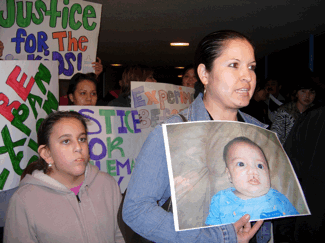
Mothers of children born with cleft palate protest the expansion of a toxic waste landfill. (Photo: Zaidee Stavely/Radio Bilingue)
[CROWD CHANTING]
YOUNG: Kettleman City, California wants answers. Babies in the poor and largely Latino town are being born with deformities and residents want to know why. Many of the 1,500 residents work in agriculture or service jobs. The town lies about halfway between San Francisco and Los Angeles. It’s a common stopping point for travelers on Interstate Five. The town’s other major employer is a sprawling chemical waste site.
For decades Kettleman City residents have fought Chemical Waste Management over proposed expansions of its landfill. The dispute has included charges of environmental racism and repeated concerns that the toxic dump is causing health problems. Now, people suspect chemical waste is to blame for the recent spike in birth defects.
Five area babies born in a 15-month period in 2007 and 2008 suffered severe birth defects -- including cleft palate, heart problems and developmental delays. Maria Saucedo, a 17-year resident of the area, gave birth to one of those children--a daughter named Ashley.
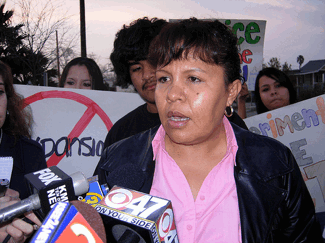
Maria Saucedo speaks with journalists in Kettleman City after the EPA visit. (Photo: Zaidee Stavely/Radio Bilingue)
[SAUCEDO SPEAKING SPANISH]
VOICEOVER: When Ashley was born, they told me she would make it a month. She wouldn't live to two months. But time passed and Ashley was five, six, seven months. I thought that she would be with me longer. But when she got to be ten-months-old I could see that what they told me was true - that she was going to die, and she did.
YOUNG: Maria Saucedo was among the residents who crowded a recent emotional meeting in Kettleman City. Health officials shared preliminary results of an investigation of the birth defects and possible causes. Reporter Zaidee Stavely with Radio Bilingue was at that meeting. She’s also visited the chemical waste facility, which covers some 1,600 acres.
STAVELY: The Chemical Waste Management facility there in Kettleman Hills is the largest toxic waste landfill in the Western United States. It takes paints, oils; it’s actually the only facility in the state that is allowed to take PCBs.
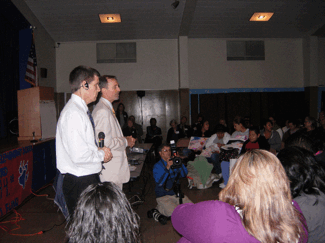
California public health officials meet with concerned residents.(Photo: Zaidee Stavely/Radio Bilingue)
The liquid PCBs there are washed out of old transmitters from telephone lines and florescent tubes, and the metal containers are dumped there in the landfill in Kettleman City. You go in and it’s basically just hills upon hills of landfill. It’s hard to distinguish between the natural mountains of the area and dirt mounds that are covering old landfills. And it’s both a regular garbage dump and also a hazardous waste landfill. So you have several different sections and it’s thousands of acres.
YOUNG: What evidence is there that the Chemical Waste facility is causing contamination?
STAVELY: There is no evidence at this point that there’s actual contamination from the hazardous waste landfill into the town. And the landfill representatives say that there have been several studies that show that they do not affect the health of the community. The community members and their environmental allies say that those studies were not intensive enough and the company’s not being scrutinized enough.
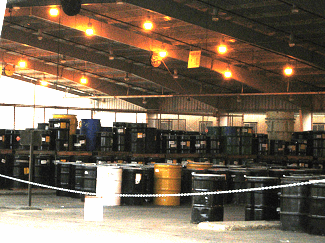
Vats of toxic waste at the landfill at the 1,600-acre Kettleman Hills landfill, owned by Waste Managment. (Photo: Zaidee Stavely/Radio Bilingue)
YOUNG: However they did find some evidence of some tainted drinking water, correct?
STAVELY: Yes, drinking water quality for the past several years has been found tainted; there’s high levels of arsenic in the water, and there has been in the past high levels of benzene, as well in the water. They think that the benzene could possibly be from past oil operations in the area. I know that also benzene is more frequently occurring near hazardous waste landfills.
YOUNG: Now, what do we know about the possible links between the kinds of birth defects that people are suffering in Kettleman City and the potential exposure to the kinds of chemicals that are in that facility?
STAVELY: There’s several studies that show that certain birth defects are more common in the vicinity of hazardous waste landfills. Unfortunately, it’s not clear why.
YOUNG: There are other risk factors that could be associated with these kinds of birth defects. I gather the public health officials tried to communicate those, but it didn’t go over very well.
STAVELY: Yes, the public health officials included in their handout a section called “Possible Causes of Birth Defects” and they did not include there any environmental risk factors. They mentioned instead use of alcohol, smoking tobacco, use of medication, and poorly controlled diabetes.
And many of the people in the town that were there at the meeting (and especially the mothers) were very upset by this. They felt that the public health officials were blaming them without ever having done interviews with them and that they were discounting an environmental factor without every having done environmental testing.
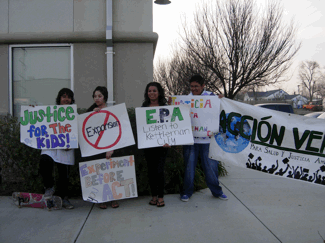
Young folks in Kettleman City urge the EPA to keep the toxic waste landfill from expanding. (Photo: Zaidee Stavely/Radio Bilingue)
YOUNG: What did the people of Kettleman City learn from this meeting?
STAVELY: The department of public health presented some of their preliminary results and public health officials looked at statistics from 1987 to 2008, and included birth defects from the entire period and said that the total number over the 22-year period in Kettleman City was not unusual.
Community members wanted more answers and the public health officials did say that in 2008 it did look like there was a spike in birth defects – that in 2008 they found four, which they say that in such a small town they would be expecting a range of between zero and three birth defects. Four seemed in excess they said and that’s why they want to investigate further.
YOUNG: You caught a moment where community members confronted the public health officials about that apparent discrepancy in the data. Let’s hear a bit of that:
[MAN SPEAKING SPANISH]
TRANSLATOR: Don’t you think that four birth defects out of 50 or 60 is a very high percentage?
RILEY: Yes, we think that four birth defects in 2008, that’s higher than had been happening in the 21 years before.
YOUNG: That was California public health official Dr. Rick Kreutzer, he promised further study – how did residents respond to that?
STAVELY: That promise was very well received. Community members and also mothers said, thank you, that’s what we want, we’re so glad the public health department is finally in our community after 50 months of asking for an investigation. And the community members were insistent that the public health department also look into environmental risk factors.
YOUNG: And the company here, Chemical Waste, they want to get bigger, right?
STAVELY: Yeah, exactly. Chemical Waste Management wants to expand their hazardous waste landfill. They say that if they don’t expand, their landfill is going to have to close and instead they’ve asked for an expansion of something around 63 acres of an extra hazardous waste landfill, which would give them another 30-odd years.
The community is pretty upset about this, as well, and they have asked that the government stop giving the company permits until this investigation of the birth defects is complete.
YOUNG: Zaidee Stavely with Radio Bilingue. Thank you.
STAVELY: Thanks, Jeff.
May Environmental Justice Prevail
YOUNG: California’s Senators, Barbara Boxer and Diane Feinstein say they want Chemical Waste Management’s landfill expansion put on hold until the investigation is complete. The U.S. Environmental Protection Agency is also taking a keen interest in Kettleman City. The EPA’s regional administrator even met with Mrs. Saucedo and others. That got the attention of experts in environmental justice.
Dr. Beverly Wright is a sociology professor at Dillard University and director of the Deep South Center for Environmental Justice in New Orleans. Dr. Wright says she’s seeing a significant change in EPA’s attitude toward environmental justice issues, starting with the new administrator Lisa Jackson.
WRIGHT: I would say that we are extremely excited about the difference that we are now seeing at EPA. We have seen an increased interest in environmental justice with an administrator making open statements that environmental justice would be one of her priorities, because as soon as she was named she immediately began an initiative to make certain that children were safe in schools around the country and launched a large-scale study.
That sends an unbelievable signal, especially when you look at the fact that in the last eight years we have seen almost no movement for protecting minorities, or people of color, or vulnerable populations.
YOUNG: Now, we’re talking about Lisa Jackson, new administrator of the EPA under President Obama. She’s the first African American to lead the agency; she’s a native or your town, New Orleans…
WRIGHT: Yes, she is.
YOUNG: How does that personal background affect her view of these issues, do you think?
WRIGHT: Her personal background does influence her concern about health in minority or people of color neighborhoods of poor communities because she comes from a city that is predominately African American and poor. And she knows firsthand about pollution.
YOUNG: You know, you mentioned Administrator Jackson’s action on air quality near public schools, and this raises another aspect of her biography and that is that she’s a mother. And when I heard that news about the schools, I said to myself, that’s a mom. That’s that a mom’s kind of activity, isn’t it?

Beverly Wright is professor of sociology at Dillard University and director of the Deep South Center for Environmental Justice in New Orleans. (Photo: Bernie Sauls Photography)
WRIGHT: Yes, it is, and she’s not just a mother, she’s a mother with a child who has asthma, and the city of New Orleans the asthma rates are extremely high among young, but we’re also a city where our first black mayor died from an asthma attack. The only fear that I have with this administration is that while Administrator Jackson is really pushing to get things done the coacher of some of these regional offices are such that she still won’t have enough time to make the changes she needs so that these new values can sort of trickle down throughout the agency.
YOUNG: What would you be watching for in a case like the Kettleman City, California case that would indicate real action and not just a change in rhetoric?
WRIGHT: When in fact you begin to see that something is taking place to protect people. In the Mississippi chemical corridor where I live, we have 136 petrochemical plants and six refineries over an 80-mile stretch of land. We release nearly 200 million pounds of toxic chemicals into the air, water and soil.
So you’re talking about an extremely polluted area. So, how do we first of all, stop the bleeding, what policies can we put in place to do that; and then, what do we do to protect the people on the ground who are being affected. If the scientists say that the science isn’t there to support that, but you’re looking at sick people, what do you do? And there are creative means that could be taken to keep the community safe.
YOUNG: It sounds like, in general, what you’re looking for is kind of an application of the precautionary principle to say, if we’re going to err it’s going to be on the side of caution and public safety.
WRIGHT: Absolutely. That’s exactly what we’re looking for. Erring on the side of caution. The bottom line for EPA should be the health of the community.
YOUNG: Dr. Beverly Wright directs the Deep South Center for Environmental Justice. Thank you very much.
WRIGHT: Thank you, bye bye.
Related links:
- EPA on Environmental Justice
- Beverly Wright's Deep South Center for Environmental Justice
[MUSIC: John Scofield “That’s Enough” from Piety Street (Emarcy Records 2009)]
YOUNG: In a minute – Women in Uganda hatch a plan for a brighter future – and it starts with chickens. Keep listening to Living on Earth!
[MUSIC: Mulatu Astatke/The Heliocentrics: “Blue Nile” from Inspiration Information 3 (Strut Records 2009)]
Cool Fix for a Hot Planet
YOUNG: It’s Living on Earth, I’m Jeff Young. Well, just ahead: how your cell phone could be fueling the fighting in Africa, but first this Cool Fix for a Hot Planet from Nirja Parekh.
[MUSIC: WALKING ON SUNSHINE]
PAREKH: Solar energy panels are making a move from their usual rooftop resting places down to our roadways. This new technology promises to create a high-tech highway to harness the sun’s energy.
[COOL FIX THEME]
PAREKH: An Idaho-based company called Solar Roadways was recently awarded a hundred thousand dollars by the U.S. Department of Transportation to produce a prototype of their solar road panel. These energy-generating panels are designed to replace petroleum-based asphalt on roads and will collect enough energy to power businesses and homes.
Each panel measures 12 by 12 feet and is strong enough for cars to drive on. The panels will absorb and store the sun’s rays in cells, and also work as the energy grid, distributing the collected power, and other services, like telephone, cable and Internet lines to homes or businesses.
The solar panels will contain embedded LEDs, which will light up the road for safer nighttime driving, while built-in heating elements keep roads from freezing over. A single panel costs nearly $7,000 to produce, but could generate up to 7,600 watt-hours daily. Researchers say if these panels are used to pave one mile of a four-lane highway, the captured solar energy could power 500 homes.
And if the project meets its goal to cut U.S. dependency on fossil fuels, it could have us walking – and driving – on sunshine. That’s this week’s Cool Fix for a Hot Planet. I’m Nirja Parekh.
YOUNG: And if you have a Cool Fix for a Hot Planet, we'd like to know it. If we use your idea on the air, we'll send you a sleek electric blue Living on Earth tire gauge. Keeping your tires properly inflated can save hundreds of dollars a year in fuel.
Email us at coolfix—that's one word - coolfix - at l-o-e dot org.
[COOL FIX THEME]
Blood Minerals Fuel Congo Conflict
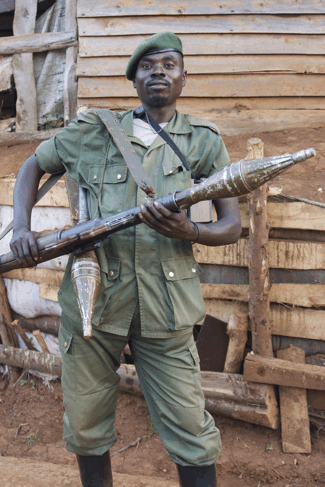
Armed groups control the majority of gold and minerals mines in eastern Congo, where villagers are forced to work as laborers. (Photo: Lezhnev/Grassroots Reconciliation Group)
YOUNG: The Democratic Republic of Congo in central Africa generates some of the world’s most shocking statistics. A decade of war claimed at least five and a half million people – the deadliest conflict since World War II. And more than a thousand still die each day from factional violence. More than a million people were forced from their homes in Congo just last year and it’s been called the most dangerous place in the world to be a woman – one in three has been raped. Now, I'm reading these statistics from a text on my handheld, my smart phone – this thing –
[DIGITAL CELLPHONE RINGTONE]
YOUNG: Which could also have a connection to Congo’s violence, according to David Sullivan. He’s with the Enough Project, a Washington, D.C.-based group that’s drawing attention to what Sullivan calls “blood minerals”. David, what’s in this phone of mine that might be from the Eastern Congo?
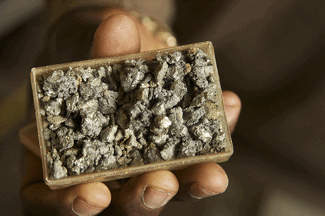
Tin ore: one of the minerals that lie at the heart of American cell phones, and at the heart of violent conflict in eastern Congo. (Photo: Sasha Lezhnev/Grassroots Reconciliation Group)
SULLIVAN: Well there's what we call the three Ts: tin, tantalum and tungsten, as well as gold. Tantalum, which in Africa is called coaltan, that’s the mineral ore, is used in something called capacitors, which are crucial to storing energy, and so are very necessary for any sort of portable electronic device.
Then you have tin. Tin is actually used as the solder, which affixes components to the circuit board of the phone. Tungsten, in particular with cell phones, it’s actually used for the vibration alert – gives the phone the capacity to vibrate. And then, gold used as a connector in various electronic products.
YOUNG: And why does so much of this stuff come from this particular spot on the planet, the Eastern Congo?

This 15-year-old boy has been working in this gold mine in eastern Congo since he was eight. (Photo: Lezhnev/Grassroots Reconciliation Group)
SULLIVAN: Well, you can get this stuff from lot’s of other parts of the world, but when it’s mined by rebel groups--often times using forced labor under pretty tough conditions--it’s cheap. And so what we hear from sources within the industry is that these minerals coming out of Eastern Congo and central Africa can be half the price of stuff that is sourced from places like Australia or Brazil, where we know it’s not contributing to conflict.
YOUNG: And this happens to be one of the most violent in the world.
SULLIVAN: Yeah, you know, it’s the deadliest war in the world since World War II. And the minerals play an important role in what is a very complicated conflict. You have sort of an alphabet soup of different rebel groups and militias like the FDLR partly responsible for the genocide in Rwanda, continuing to operate in Eastern Congo where they both control some of these mines and also illegally tax other mines, and are able then to purchase weapons even when other governments and other sources of support have cut off these militias.
And among the worst is actually the Congolese army itself, which although it’s supposed to protect the population there, winds up preying upon the population committing some of the worst atrocities against them. And the Congolese army is also very much involved in the minerals trade; they’ve actually taken control of some mines from the rebels, but then continue to practice the same exploitation of the population. So, you have the worst armed groups on all sides of the conflict continuing to profit from the trade of these minerals.

Armed groups control the majority of gold and minerals mines in eastern Congo, where villagers are forced to work as laborers. (Photo: Lezhnev/Grassroots Reconciliation Group)
YOUNG: And do we know roughly how much money is flowing to these competing groups?
SULLIVAN: Well, my organization, based upon some really rough back-of-the-envelope calculations, we think the order of magnitude of this is approximately 180 million dollars a year.
YOUNG: Well, now that’s a lot of money here, I’m guessing it’s a whole lot of money there. Put that in context for us, say compared to – I don’t know, the average income for someone living and working in the Congo.
SULLIVAN: That’s quite a lot more than that. Congo’s one of the poorest countries in the world. The miners themselves who are engaged in really backbreaking work and abysmal conditions in mines frequently subject to caves and all sorts of social and environmental hazards – they earn about a dollar a day.
YOUNG: So this little handheld I’m looking at right here, this would be equivalent to roughly the annual income of one of those workers?
SULLIVAN: Yes, that’s about right.
YOUNG: So, I’m looking at my phone and now I’m looking at it somewhat guiltily, but I guess I could also look at that and say, “ah ha” here’s my leverage to make things different, right?
SULLIVAN: That’s exactly right, we can use our consumer power to demand from the companies that we purchase from that they change the way they do business, and that they put in place the systems to keep the conflict minerals out of our phones. And that’s going to help contribute to a broader effort to actually resolve the conflict in Eastern Congo.
YOUNG: Yeah, many of us are familiar with conflict-free diamonds where the companies give us some assurance they know the source. Is that the model that you think can be applied to these minerals and the companies that use them?
SULLIVAN: Ultimately, I think that is the model. What we would like to see actually is a kind of shifting of the burden of proof because right now companies cannot tell you with certainty that they are not sourcing minerals from Eastern Congo. They instruct their suppliers not to, but they don’t have the checks and balances in their supply chain to be able to prove that their products do not contain these conflict minerals. And so what we would like to see is for those companies to really verifiably prove to consumers where they do get their minerals from.
YOUNG: So, when you approach companies with that idea, what do they say?
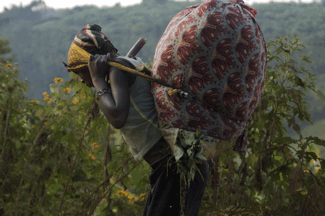
A woman carries a load into town. Aid groups estimate one in three women in eastern Congo have been raped. (Photo: Lezhnev/Grassroots Reconciliation Group)
SULLIVAN: Well, certainly no company wants to be in favor of conflict minerals, but we’ve yet to see the really bold leadership from the industry that’s going to make the difference. You know, companies are still competing based upon price and so to actually be the first to put in place the systems that would actually exclude these minerals from their supply chain, they see that as putting them at a competitive disadvantage.
So, we really need to up the volume around this issue so that companies start to see a demand for these conflict-free goods. And there’s actually been progress on Capitol Hill, both in the Senate and the House of Representatives, legislation has been introduced that would provide for greater transparency in these supply chains.
YOUNG: But has the effort on blood diamonds really worked all that well or are there weaknesses there?
SULLIVAN: In many ways the efforts have been remarkably successful. I think that the attention from consumers and the pressure on industry during the late 90’s and early 2000’s did actually help contribute to resolving very violent wars in Liberia, Sierra Leone and Angola that were very much fueled by diamonds.
Today, there are problems with how that process is working, particularly in the case of Zimbabwe where blood diamonds that are controlled by that country’s army have been slipping into global supply chains and getting around the process that’s been set up to keep those diamonds out of global markets.
YOUNG: You know, it seems that whether it’s diamonds or minerals in our electronics products it’s all sort of part of a bigger story about global consumption, where we the consumers in the developed world really don’t know that much about where our stuff comes from and what is the true cost of giving us this stuff. Do you see that beginning to change at all?
SULLIVAN: I think that there’s certainly a recognition that this issue of conflict goods is just the tip of the iceberg of wider concerns about where the things that we consume actually come from. And you see that whether it’s in terms of people now wanting to know exactly where the food they’re eating comes from and demand for fair trade products, and increasingly recognize that we need to really get to the bottom of these supply chains and ensure that things like child labor, labor rights, and environmental concerns, as well as these human rights concerns – really make a change.
YOUNG: David Sullivan with the Enough Project, telling us about blood minerals. Thank you very much.
SULLIVAN: Thanks a lot.
Watch video by the Enough Porject about the conflict mineral supply chain.
Related links:
- Learn more about conflict minerals and what you can do about them at Enough Project’s conflict mineral web portal.
- Check out David Sullivan's recent report on the conflict minerals trade "Digging In"
Poultry Promise
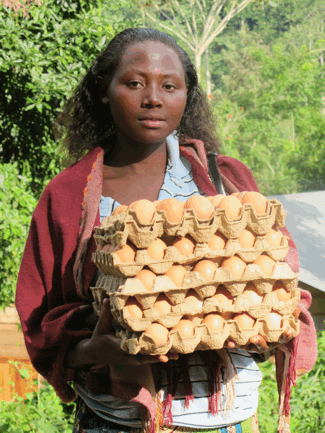
Chance Christine now has eggs, chicken and cash. She keeps seventy hens in a backyard coop. (Photo: Beth Hoffman)
YOUNG: And now for a more hopeful story from Congo’s neighbor to the east, Uganda. In Uganda, as in much of Africa, many women work as farmers, and many of them are very poor. Women often don't own the land they farm, and can’t get loans to buy high quality seeds. In East Africa, there's a movement to help women farmers with a low-tech solution that could help them build a nice little nest egg. Beth Hoffman reports from Uganda.
[SOUNDS OF CHICKENS]
HOFFMAN: Bhoma looks like a typical town in Uganda. The land is green and rolling, the roads dirt and the buildings made of mud plaster. Tiny shops line the road, selling salt, biscuits and eggs, while barefoot kids run and play.
[SOUNDS CHICKENS AND CHILDREN]
HOFFMAN: And like most places in Africa, Bhoma has chickens, scavenging around town. But here, chickens also mean business.
CHRISTINE: This is the mash.
HOFFMAN: This is mash. 24-year-old mother and entrepreneur Chance Christine dips a blue plastic bowl into the store-bought feed she calls mash – a mix of corn and vitamins. Holding her crying, coughing 14-month old in one arm, she unlatches the door to the chicken coop.
[SOUND OF DOOR UNLATCHING]
HOFFMAN: Inside are about seventy small, brown hens ready for their breakfast. They dash to the feed leaving their precious eggs behind. Christine holds one egg up to her ear and gently shakes it to see if it's fresh and unfertilized.
[CHRISTINE SPEAKING RUCHIGA]
VOICEOVER: I shake it and if nothing moves, the egg is good. If something moves inside, then the egg is not good.
HOFFMAN: It’s the most mundane of scenes – smelly chickens, crying babies – but these chickens are perhaps Christine's best chance to get her family out of poverty.
[CHRISTINE SPEAKING RUCHIGA]
VOICEOVER: Before the chickens I was selling porridge by the roadside. We didn’t have enough to eat, and we couldn’t buy clothing for the three boys. We didn’t have enough mattresses.
HOFFMAN: So, with help from a local group…
[CHRISTINE SPEAKING RUCHIGA]
VOICEOVER: We took out a loan.
HOFFMAN: And started a chicken business…
[CHRISTINE SPEAKING RUCHIGA]
VOICEOVER: There was nowhere to buy eggs and people were coming past here going to the neighboring town to buy them. So we started raising chickens to cater to the community, and because they help my family.
[SOUNDS OF FARM FADE]
MUGISHA: If we want to help women and children, I think investing in local chicken is very, very important. HOFFMAN: Anthony Mugisha sits behind a large wooden desk in his office at Makerere University in Uganda’s capital city, Kampala. Mugisha is a Professor of Animal Health and Social Economics, and works with the FAO – the U.N. Food and Agriculture Organization.
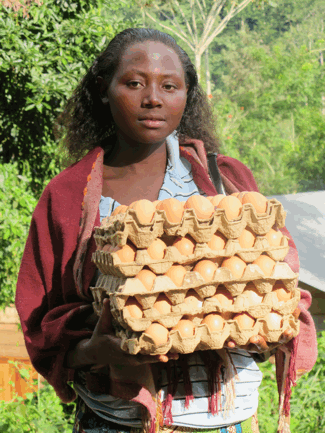
Chance Christine now has eggs, chicken and cash. She keeps seventy hens in a backyard coop. (Photo: Beth Hoffman)
MUGISHA: To sell a cow it takes big decision; it’s a big animal. But if you need salt, you need paraffin, you need soap – just pick one chicken and sell it in the market and get money. It solves immediate problems. When people talk of food security, they think of crops – but you can find there are some households where they have enough food – they’ve got bananas, they’ve got maize – but the children are undernourished because they are not getting the balanced diet of animal protein.
HOFFMAN: And there are other reasons why raising chickens in Africa makes good sense. For one, as the population increases, available land decreases – yet farmers don’t need a lot of land to raise chickens. Grazing cattle in a changing climate is also unpredictable – but chickens can cope with drought and flood far better than cows. Chickens also turn grains into high value protein, fast. And for women farmers, chickens are socially acceptable to own and sell – without asking a man's permission.
[AMBIENCE OF NAKATE'S HOME]
HOFFMAN: But perhaps most important, unlike growing cash crops or milking dairy cows, poultry doesn’t mean a lot of extra work for already overburdened women.
[SOUND OF CHICKENS]
[NAKATE SPEAKING LUGANDA]
VOICEOVER: I take care of a household of sixteen people. Some are my biological children; others are orphans and grandchildren whose parents have died.
HOFFMAN: Clementia Nakate is a tall and lean 55-year-old woman who lives in the Rakai District of southwestern Uganda. She lost her husband in 1999 to AIDS, and like many women in the area, she now cares for grandchildren and orphans, even though she too is HIV positive.
[NAKATE SPEAKING LUGANDA]
VOICEOVER: When my husband died, I received counseling – to deal with the bad memories of his death. But CIDI also supported me to get into poultry farming.
HOFFMAN: CIDI – the Community Integrated Development Initiative – is just one of many grass roots NGOs across Africa working to promote poultry farming for women’s empowerment. Tanzania, South Africa, Ethiopia, even Bangladesh – have all adopted similar programs. They also encourage women like Nakate to form farmer cooperatives.
[NAKATE SPEAKING LUGANDA]
VOICEOVER: Our group is mainly made up of widows – we share and counsel together, and they help me to be emotionally well. We also visit each other during the month to share ideas on how to improve our lives and our chicken farming.
[ROOSTER CROWS]
KIGULA: Chicken is part of me. I sleep chicken, I walk chicken. I love chicken, I eat chicken
HOFFMAN: That's Dan Kigula. He's an extension agent, really a poultry proselytizer for CIDI in this part of Uganda. Village women call him Mr. Chicken.
KIGULA: They call me Kigula Chicken. Kigula Encoco. And I’m proud of that.
HOFFMAN: Kigula is excited about chickens because they changed his life too.
KIGULA: You put money in chicken. You get chickens to eat, you get chickens to sell. You get eggs to eat, you get eggs to sell. Another thing that I get fertilizers – the droppings, they have a lot of nitrogen. Then you take them in the garden, and you harvest – you get money.
HOFFMAN: Of course, raising chickens is not a miracle cure. Fast spreading diseases like Newcastle can wipe out whole flocks. The cost of commercial feed keeps rising and good markets can be hard to find. And so women adapt and innovate. Nakate decided to raise only local chicken breeds, which require less costly feed. And Chance Christine has found a way to tap into the tourist trade.
[CHRISTINE WALKS IN AND SAYS GREETING]
HOFFMAN: She approached lodges in nearby Bwindi, where Europeans and Americans come to track gorillas.
[NAKATE SPEAKING LUGANDA]
VOICEOVER: I only brought five trays today, but I will bring five more on Thursday.
HOFFMAN: At more than three dollars a tray, she can make about 90 dollars a month delivering eggs to this lodge alone. That covers the cost of feed. It will also cover the cost of school for her children, a luxury her parents could not afford for her just twelve years ago.
CHRISTINE: My parents they were living in poverty…
VOICEOVER: My parents were living in poverty and they failed to get the money for me to study. They couldn’t pay the school fees.
HOFFMAN: With chickens, Christine and other women of this region hope that reality is a thing of the past. For Living on Earth, I’m Beth Hoffman in Uganda.
[CHILDREN SINGING]
YOUNG: Coming up: giant deep sea worms had marine biologists puzzled –
SHAPIRO: Riftia worms have no mouth, no anus, no gut, and they stay put. So how do these things eat? No one knew.
YOUNG: It turns out – they get by with a little help from their friends – that’s just ahead on Living on Earth.
[MUSIC: Steve Cropper/Various Artists “With A Little help From My Friends” from Stax Does The Beatles (Stax Records 2007)]
ANNOUNCER: Support for the environmental health desk at Living on Earth comes from The Cedar Tree Foundation. Support also comes from the Richard and Rhoda Goldman Fund for coverage of population and the environment. And from Gilman Ordway for coverage of environmental change. This is Living on Earth on PRI – Public Radio International.
[MUSIC: The Bad Plus: “This Guy’s In Love With You” from Prog (Do The Math Records 2007)]
Pundits Blow Whistle on Green Police
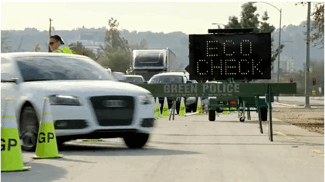
The Audi A3 TDI played a supporting role to the Green Police (Courtesy of Audi)
YOUNG: It’s Living on Earth, I’m Jeff Young. If you watched the Superbowl, you might have caught the new ad for Audi’s A3 TDI, a low-emissions diesel car. The ad features an aggressive eco-vice squad.
AD: Okay, so it’s 37.08. Paper or Plastic? Plastic. That’s the magic word – Green Police. You picked the wrong day to mess with the ecosystem, plastic boy!
[GREEN POLICE SONG]
AD: Battery! Battery! Let’s go, take the house. Put the rind down. Sir, that’s a compost infraction!
YOUNG: The green police bust enviro-violators for plastic bottles and incandescent light bulbs. They inspect cars at a roadblock, where the Audi, of course, gets the green light.
AD: We got a TDI here, clean diesel. You are good to go, Sir.
[CAR ENGINE VROOMS AWAY]
YOUNG: Well that Superbowl spot kicked off a bit of controversy with conservatives, liberals, environmentalists and industry all feeling equally aggrieved by Audi’s ad. John Carroll’s here to help us work out just what’s going on. He teaches Mass Communication at Boston University and when it comes to over-thinking advertising he’s our go-to-guy. John – welcome back!
CARROLL: Nice to be back.
YOUNG: Well, Audi’s trying to sell the green car of the year here by poking fun at greens. That’s kind of an odd way to try and sell something, isn’t it?
CARROLL: Not really, I mean I think what they’re looking for is an audience that can appreciate this kind of approach. This is a terrific spot for a number of different reasons. One of them is the pacing of the spot – they have the audience on a string for the first 45 seconds, not knowing who this thing was for until they rolled out the Audi.

The Audi A3 TDI played a supporting role to the Green Police (Courtesy of Audi)
The other part of it is the execution; I mean they had rolled every visual cliché available from newscast, entertainment programs, advertising all into one sort of green pig-in-a-blanket. And it’s so visual comforting that it just draws people in to the action. And then the third thing is the ambiguity of it. Even now, the debate’s going on: who should really be offended by this? And you don’t know who’s behind the thing for so long – it could be the treemuggeratti, it could be the plastics industry, it could be Al Gore – you have no idea. And that’s kept it alive for a whole week.
YOUNG: And here we are doing our part by talking about it.
CARROLL: Exactly.
YOUNG: A lot of people took this fairly seriously and seemed to get a little ticked off. Let’s start with the environmentalists. They say this is a negative portrayal. Environmental blogger Adam Segal declared it “offensive on many levels. It promotes a view of environmentalism as heading toward a police state.”
CARROLL: I think that’s going a little bit overboard. The egotists dislike this spot because it reinforces the common image of the sort of know-it-all, P.C. hall monitors who are out there. And I think that upsets them because people don’t take them seriously enough when they go out and try to deliver their message. So I think what they’re seeing is their credibility being chipped away at.
YOUNG: The conservative blogosphere also lit up over this with comments like this one: “Wake up, people, the green police are already here!”
CARROLL: Yeah, I think that’s part of it, that’s half of the conservatives. The other group of conservatives who dislike it is that it makes the green police look like Monty Python rather than the menace that conservatives believe they are. So, there are so many different shades of green here that you can see in this spot. It’s one of the best things about the spot. I mean, it’s a litmus test or a Rorschach test for every interest group out there.
YOUNG: You know, actually, I think they mostly resemble the guys at “Reno 9-1-1”.
[CARROLL LAUGHS]
YOUNG: If anybody should be offended it should be them, they got ripped off here, but that’s just my impression. And lastly, the plastics industry is offended here – the plastics counsel put their own website in retaliation called: Green Police Confused, with helpful tips about why plastics are really good for you. What do you think – did the plastics guys get a bum rap in this ad?
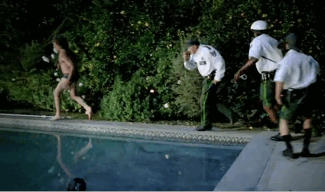
A hot tub owner resists arrest from the Green Police. (Courtesy of Audi)
CARROLL: I think they’re an easy target, I think they feel unfairly singled out, but it’s everybody who’s being sort of mocked here and held up for satire.
YOUNG: You know, I like it, I chuckled. And they had me from the get-go because I’m a sucker for power pops, so I heard the opening chords of that Cheap Trick song and just psshhh –
CARROLL: Yeah.
YOUNG: But I had a hard time figuring out who’s the target audience? What’s the demographic they’re after here?
CARROLL: Well one of the theories is that the demographic they’re after is upscale. It’s obvious that it’s upscale white males who are being busted in these scenarios. From one standpoint anyway that the upscale male who wants to be environmentally conscious but doesn’t really want to work at it too much can go out and buy a cool car and do his bit for the environment.
So I think it’s not the committed, they don’t need to attract them – they’ve already got them. It’s the people who are looking for a way that’s easy and stylish to be environmentally conscious, and if they have enough money those are the ones who I think Audi is targeting.
YOUNG: You know, this is kind of a tough sell for Audi ‘cause the clean diesel is not really a well known concept here, I think it’s better known in Europe, but here it almost sounds like an oxymoron to people who remember older diesel vehicle, which were quite dirty. They’re not really playing up the car itself in this ad, are they?
CARROLL: No, I don’t think that’s the purpose of this. There’s a 106 million people watching, having fun, eating nachos and drinking beer. I mean I don’t think they want to get into any kind of serious discussion of clean diesel at that point. I think what they want to do is get themselves on the radar screen. I think the whole purpose of this was to grab people’s attention and let them know that the car is there.
YOUNG: John Carroll teaches Mass Communications at Boston University and blogs at campaignoutsider dot com. Thanks a lot.
CARROLL: Thank you, Jeff.
Watch the Green Police in action.
Related links:
- The plastics industry quickly posted a new website in response.
- Audi has more adventures from the Green Police as well as a free mp3 for the reworked Cheap Trick hit.
- Hear more of John Carrol's media analysis here.
[MUSIC: Donald Fagen “Green Flower Street” from The Nightfly (Warner Bros. 1982)]
Swinging Swans

(Photo: FLICKR/Mozzercork)
YOUNG: Images of canoodling swans are common around Valentine’s Day – those graceful birds that mate for life are living symbols of lasting love. Right? Well, it is with mixed emotions that we bring you a story about a bit of a flap on a certain swan lake.
[SOUND OF SWANS HONKING]
YOUNG: Those are Bewick swans, recorded on Valentine’s Day 1966 at the Wildfowl and Wetlands Trust Centre in Slimbridge, England. Each year the birds return to Slimbridge in their life-mated pairs from nesting grounds in the far north. But this year, naturalists like Julia Newth noticed something that has ruffled a few feathers. Ms. Newth is a wildlife health research officer at the center, welcome to Living on Earth!
NEWTH: Hello, hello!
YOUNG: So what’s going on with these swans?
NEWTH: Well, it seems that we’ve witnessed a divorce, a swan divorce this winter. A faithful pair called Sarindi and Saruni have been returning a few years as a couple. Sarindi flew in with a new partner in December and you know we kind of thought perhaps something untoward had happened to her old mate, Saruni. So, we were therefore very surprised when Saruni rocked up a few weeks later also with a new partner.
YOUNG: Scandalous!
NEWTH: It is! It’s very unusual in the swan world, certainly, for this to happen.
YOUNG: How unusual? I mean, does this happen from time to time? Is this a first of its kind?
NEWTH: This is actually the second time that we’ve witnessed this at Slimbridge, but bearing in mind this is almost 40 year of studying the swans intensively at Slimbridge, and that includes the studying of over 4,000 pairs. So, this really is quite an unusual event.
YOUNG: Before we seem too judgmental about this certain swan couple, I guess we should point out that over 40 years just two examples of splits, that’s a darned better marriage success rate than we humans can claim.
NEWTH: [Laughs] It seems to be, yes.
YOUNG: Any ideas about why they split up?
NEWTH: One possible scenario could be – I mean, Saruni and Sarindi never brought cygnets back to Slimbridge and they were never known to have bred before, so this failure to breed could be a possible reason as to why they’ve split. Certainly in the case of divorce previous to this, it was a similar pattern; the pair had never brought cygnets back to Slimbridge. So, we can really only speculate, but this could be possible reason.
YOUNG: Do we know yet if the new pairings might be more successful in producing cygnets?

(Photo: FLICKR/Mozzercork)
NEWTH: Well, this is what’s going to be fascinating actually next winter; the Bewick Swans will be leaving on migration to Russia towards the end of February. They’ll hopefully return again in October. So, hopefully we’ll be able to kind of gather a bit more meat to the story. It will be very interesting to see whether either pair brings back cygnets next year.
YOUNG: Is this an opportunity to learn more about what happens when monogamous pairing breaks down?
NEWTH: We’re certainly watching very closely. I mean at Slimbridge we’re able to identify all the individual swans that come winter here by their distinct bill pattern, which is a little bit like a unique thumbprint that us humans might have. So, we know exactly who’s paired with who, and we’ve got both pairs back on the same lake now, so we’re certainly watching very closely.
YOUNG: So, what’s that interaction like? This is, you know, anthropomorphizing the whole affair, but it’s got to be a little awkward for them, isn’t it?
NEWTH: Well, it’s been very interesting because we haven’t actually seen all that much interaction between Saruni and Sarindi – the old pair, the divorced pair – I mean, they no doubt recognize each other, they’re very sociable creatures, they’d been together for a number of years, and they recognize each other through particularly their calls to each other.
We’ve actually seen them in very close proximity of each other, within meters. Given that, we’re kind of surprised that we haven’t seen any kind of display of any kind, whether it’s aggression or affection. So, we’re kind of looking for telltale signs of some kind of interaction. I’m sure they’ve communicated, but nothing too obvious as of yet.
YOUNG: And what’s the reaction been among people who come to see the swans there?
NEWTH: Every Bewick Swan assemblage is recognized and named as an individual, so I think people kind of have an empathy with them because of that. And this kind of case of divorce is almost kind of a very modern quality, if you like. Some people have said it’s a sign of the times. So, I think people feel very connected to this kind of behavior in a way, and they can – well, some people can relate to it. So, it’s generated a lot of interest back at Slimbridge.
YOUNG: Why is it that swans mate for life, anyway? I mean, we project virtue on this, but there’s real biology going on here – why do they do it this way?
NEWTH: Well, particularly for the Bewick Swans they’re migrating from their summer breeding grounds in Arctic Russia, that’s 3,000 kilometers away. And when they arrive back up to breed on the tundra in May, they’ve only got a very short window in which to reproduce, rear the young so that they can fly back to their wintering grounds in September in northwest Europe. So, they really only have a very short turnaround there, so we think monogamy kind of benefits them. If they have the same partner it cuts out time they have to spend otherwise looking for a new mate.
YOUNG: And has this at all shaken your belief in the swan as a symbol of undying love?
NEWTH: It hasn’t really. At the moment at Slimbridge we have a number of pairs and a number of long standing pairs. You know, just a few years ago we had a pair called Lemonia and Laburnum and they had been returning together for 21 years, so there’s plenty of birds out on the lake at the moment that are really showing the characteristics of monogamy.
YOUNG: So, no signs here that the honeymoon’s over, as it were, with the swans and mating for life? That’s still the norm here?
NEWTH: Absolutely, absolutely. Yes. It’s just such a rare occurrence here. It’s a very fascinating thing to be observing, but I have every faith the Bewick Swans particularly will continue to show their usual displays of monogamy.
YOUNG: Julia Newth with the Wildfowl and Wetlands Trust Center in Slimbridge, England. Thanks very much.
NEWTH: Thank you.
Oceanic Give and Take
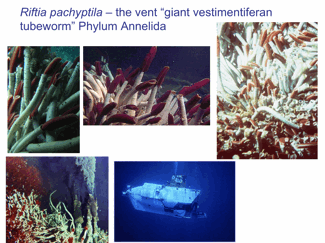
(Courtesy of Colleen Cavanaugh)
YOUNG: Well, the natural world still has a lot of surprises. That’s certainly true when we look at symbiosis – the often mutually beneficial relationships between some species.
About a century ago, a young British naturalist named Beatrix Potter – yes, that Beatrix Potter – first proposed that lichens are examples of symbiosis. Her idea was dismissed at the time, but she was right. And the study of symbiosis continues to reveal all sorts of discoveries in some of the most unexpected places. Here’s one not from the past, but from the depths. Reporter Ari Daniel Shapiro has our story.
SHAPIRO: For 30 years, scientists have traveled to the very bottom of the ocean thanks to Alvin, an underwater vehicle.
CAVANAUGH: Yes, Alvin is, I always say it’s the submarine, not the chipmunk.
SHAPIRO: Colleen Cavanaugh is a biology professor at Harvard University, and she’s spied on the seafloor from inside Alvin a number of times.
[CAVANAUGH GIVING DIRECTIONS INSIDE SUB:
Alvin audio, recorded June 3, 1992, courtesy of Professor Colleen Cavanaugh]
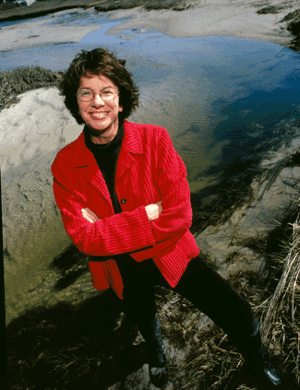
Harvard biology professor Colleen Cavanaugh. (Photo: Jim Harrison)
CAVANAUGH: It’s a so-called manned, which I call it a womanned submersible. It has a pilot and carries two scientific observers.
SHAPIRO: And it’s tiny. The space where you actually sit, there’s barely enough room to stretch your arms out to the sides. Tiny portholes let you look out. Not that there’s that much to see.
CAVANAUGH: Most of the deep sea just looks like sediment or black rock, you know, very, very few organisms.
SHAPIRO: But the story’s different at places called hydrothermal vents. Basically, they’re hot springs on the ocean floor. It’s where two plates at the bottom of the ocean are being pushed apart as magma comes up. The magma’s hot and acidic and has all kinds of chemicals in it like sulfur. And, says Cavanaugh, it’s stunning when you’re in Alvin and you approach a hydrothermal vent.
CAVANAUGH: And you start way out, you start to see a crab here, and a crab there, and then, you know, maybe a fish goes by. And as you get closer and closer, there is more and more life. When you actually come up to them, it’s an oasis. It’s biomass that rivals a rainforest.
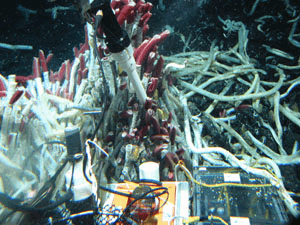
Alvin manipulates sensors to determine the geochemical environment around this Riftia pachyptila clump. (Courtesy of Colleen Cavanaugh)
SHAPIRO: When these hydrothermal vents were discovered, they completely blew open the view of the deep ocean as an empty, lifeless desert. There was tons of life down there. Thickets of it. One of the creatures in this deep-sea rainforest is something called Riftia.
CAVANAUGH: A Riftia is… well, they’re so called giant tubeworms. They get up to two meters in length.
SHAPIRO: So imagine a long, white tube as tall as your refrigerator and as wide as a roll of quarters.
CAVANAUGH: And the part that you see that’s so astonishing is that they have these brilliant red plumes.
SHAPIRO: Like a pair of wide, ruby lips at the end of this white tube.
CAVANAUGH: And this is effectively their gill, or their lung. It’s the equivalent of our lung. The red that you see is actually due to hemoglobin. So just like we have hemoglobin that carries our oxygen, so do these worms. And this hemoglobin is unique in that it binds both oxygen, like us, but it also binds sulfide in a separate spot.
SHAPIRO: Strange enough yet? A worm at the bottom of the ocean as tall as your fridge that’s got hemoglobin just like we do. And here’s the really weird part about Riftia.
CAVANAUGH: As an adult, it’s completely mouthless and gutless.
SHAPIRO: That’s right. Riftia worms have no mouth, no anus, no gut, and they stay put. So how do these things eat? No one knew. Until Cavanaugh had a kind of epiphany almost 30 years ago.
CAVANAUGH: It was a moment, but it took a while to prove.

(Courtesy of Colleen Cavanaugh)
SHAPIRO: She was sitting through this talk during graduate school that wasn’t what you’d call riveting…
CAVANAUGH: So unbelievably, I was still awake, when I jumped up and said, it’s perfectly clear. They’re effectively like plants but using sulfur instead of sunlight. I mean they must have sulfur-oxidizing chemosynthetic bacteria.
SHAPIRO: Cavanaugh’s revolutionary idea was that a special kind of bacteria lives inside the Riftia worms and actually feeds them. The bacteria use the energy from all the sulfur billowing about the hydrothermal vents to make food – carbohydrates and proteins – for themselves and for the worms.
But this is a two-way street. The Rifita use their hemoglobin to bring the sulfur right to the bacteria’s doorstep. And the worms also give the bacteria a place to live.
CAVANAUGH: Yes, so they’re providing a home, a, in quotes, a warm, cozy environment. Neither the animals nor the bacteria could survive without the other.
SHAPIRO: And it turns out that this discovery opened scientists’ eyes to the fact that this kind of symbiosis, the kind involving inorganic chemicals like sulfur, is happening everywhere. Not just at the deep-sea vents. But also in shallow coastal places // and maybe even on other planets. All these critters, helping each other make a go of it in the universe. And all we had to do was take a lesson from a worm at the bottom of the ocean. For Living on Earth, I’m Ari Daniel Shapiro.
YOUNG: Well for photos and to hear more stories like this one about marine organisms, check out the podcast of the Encyclopedia of Life. You’ll find a link on our website: l-o-e dot org.
Related links:
- Cavanaugh Lab
- Atlantic Public Media
- Podcast of the Encyclopedia of Life
[BLOWING NOISES]
YOUNG: We leave you this week at a remote bend in Africa’s River Mara.
[HIPPOS CALLING]
YOUNG: The Masai of Kenya have a saying: hippos spend their day on the river bed telling jokes and then surface as the sun goes down to laugh. Recordist Chris Watson watched about 20 hippos at dusk emerge from the river for dinner. He recorded their chatter, which can be found, along with other recordings of wildlife, on his CD called “Outside the circle of fire.”
[HIPPOS SPLASHING, GRUNTING]
YOUNG: Living on Earth is produced by the World Media Foundation. Our crew includes Bobby Bascomb, Eileen Bolinsky, Bruce Gellerman, Ingrid Lobet, Helen Palmer, Jessica Ilyse Smith, Ike Sriskandarajah, and Mitra Taj, with help from Sarah Calkins, Marilyn Govoni and Sammy Sousa. Our interns are Emily Guerin and Bridget Macdonald. Special thanks today to Joanna Grubel. Jeff Turton is our technical director. Alison Lirish Dean composed our themes. Steve Curwood is our Executive Producer.
You can find us anytime at l-o-e dot org. I’m Jeff Young. Thanks for listening.
ANNOUNCER: Funding for Living on Earth comes from the National Science Foundation, supporting coverage of emerging science. And Stonyfield Farm, organic yogurt and smoothies. Stonyfield pays its farmers not to use artificial growth hormones on their cows. Details at Stonyfield dot com. Support also comes from you our listeners, The Ford Foundation, The Town Creek Foundation, The Oak Foundation, supporting coverage of climate change and marine issues. The Bill and Melinda Gates Foundation, dedicated to the idea that all people deserve a chance to lead a healthy, productive life. Information at Gates Foundation dot org. And Pax World Mutual Funds, integrating environmental, social and governance factors into investment analysis and decision making, on the Web at Pax World dot com. Pax World – for tomorrow.
Living on Earth wants to hear from you!
Living on Earth
62 Calef Highway, Suite 212
Lee, NH 03861
Telephone: 617-287-4121
E-mail: comments@loe.org
Newsletter [Click here]
Donate to Living on Earth!
Living on Earth is an independent media program and relies entirely on contributions from listeners and institutions supporting public service. Please donate now to preserve an independent environmental voice.
NewsletterLiving on Earth offers a weekly delivery of the show's rundown to your mailbox. Sign up for our newsletter today!
 Sailors For The Sea: Be the change you want to sea.
Sailors For The Sea: Be the change you want to sea.
 The Grantham Foundation for the Protection of the Environment: Committed to protecting and improving the health of the global environment.
The Grantham Foundation for the Protection of the Environment: Committed to protecting and improving the health of the global environment.
 Contribute to Living on Earth and receive, as our gift to you, an archival print of one of Mark Seth Lender's extraordinary wildlife photographs. Follow the link to see Mark's current collection of photographs.
Contribute to Living on Earth and receive, as our gift to you, an archival print of one of Mark Seth Lender's extraordinary wildlife photographs. Follow the link to see Mark's current collection of photographs.
 Buy a signed copy of Mark Seth Lender's book Smeagull the Seagull & support Living on Earth
Buy a signed copy of Mark Seth Lender's book Smeagull the Seagull & support Living on Earth

